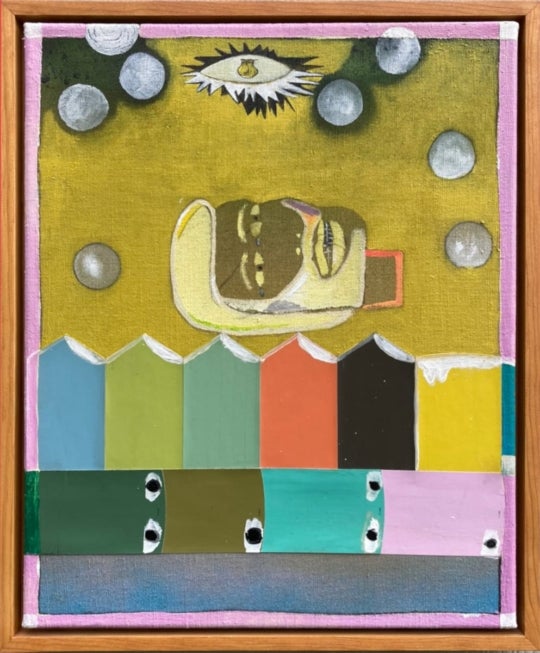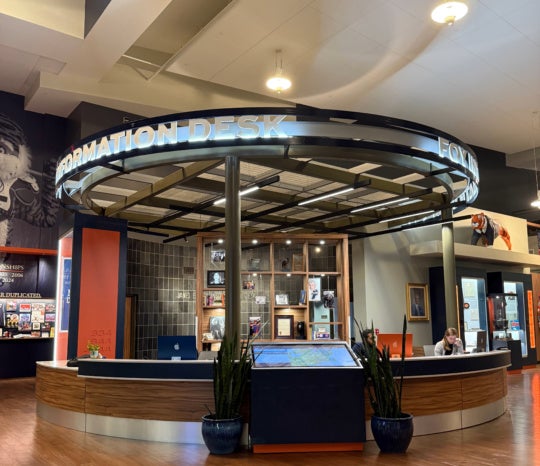
Recently I went to visit the talented and always affable Amy Pleasant in her studio, located in historic downtown Birmingham. Pleasant, who just turned 42 in October and has been painting for more than half her life, is probably best known for her “storyboard” canvases: constellation-like compositions that chart simultaneously mysterious and mundane narratives. Amy also does drawings on paper, wall drawings, and recently an installation of what she terms three-dimensional drawings.
Film and cinematography are easily recognizable influences on Amy’s visual vocabulary, but in our conversation it’s archaeology that she most frequently cites as inspiration for her creative practice. Archaeological fieldwork almost functions as a blueprint for Pleasant’s method of presenting visual narrative. The painstaking steps involved in unearthing a historical artifact and reconstructing its meaning are mirrored in the way that Amy resurrects, in layers, the seemingly banal moments buried in memory and re-examines their significance.
When I meet with Amy we talk about how her work is evolving and how those changes signal a sort of formal and conceptual distillation for her. The ideas and imagery that have always informed her work are still there, but they’re becoming leaner, more muscular.

Joanna Wilson: Okay, so you have a show that you’re working on?
Amy Pleasant: I am. I’m working on a show for whitespace gallery in Atlanta, and I’ve known [director and owner] Susan Bridges a long time and I love the gallery space. So my show is going to open on January 10, and I’m excited about this one in a way that’s been different for me because the space is so unique. I feel like I have to engage the space in a whole different way than I have before. So I’ve been thinking about different ways of installing [the work]. The work and the space will kind of, you know, animate each other.
JW: So, are you creating all new work for this show?
AP: All new work, yes. I think the show is going to be a lot about my own examining of the work, my own examination of the language. And you know, it’s so funny. Since I was a little kid I’ve always been really interested in archaeology, and so much of my work has been influenced by relics, and in a way I feel this show is about my own archaeological dig of what I do.
JW: Do you feel like you’re working differently than you usually do?
AP: I think all of the work is following a line in a way—It’s interesting, I’ve been talking about this a lot lately. But I’m starting to examine the imagery in a deeper way. I think the works are less narrative, and I’m focusing more on the images. And I think the work’s becoming slower. I think the work’s even quieter than it was before. And I feel like what I’ve been doing over the last few years is taking all the parts out that are really kind of extra. So I think that’s what’s really kind of different about it—and really kind of [closing] in on small moments.
JW: What do you mean by small moments?
AP: Well, instead of maybe having this whole story unfold like the storyboard paintings, I’m taking one piece of that out and blowing it up, just focusing on those singular moments and repeating them. And I’ve always worked with things that we do in our lives that are repetitious, really ordinary things, but I feel like they’re even more stripped down now than they were.

JW: I was going to ask you about the thread between the storyboard paintings and your new work. It seems like recently your figures are a lot larger and are almost like close-ups of the paintings that you were working on.
AP: Yeah, that’s exactly how I think about them. In my art I’ve always thought about film and [about] using a storyboard that a filmmaker would use to map out a whole scene. And I’m really interested in that kind of changing of perspectives; how it affects the way you experience the scene. What is this thing that you are showing, and how are you showing it?
JW: I keep seeing the backs of people’s heads appear in your work. Have they always been there?
AP: Yes, but it’s become a real focal point in the work in the last couple of years. Again, I think of it in terms of the cinematic. You get these scenes where you get these [real] close-ups of two people talking to each other, or you’re getting a view of the character looking at something. So, I’m just really fascinated by that idea and also [by] not having the identity of the person—recognizing that it is a figure, but … never [seeing] the face. And I don’t know, people always talk about how my work is voyeuristic or you’re looking in on something private and quiet. My work is very much about reflective moments and those times that you’re taking something in and thinking about it.

JW: Are there any colors you’ve been drawn to recently?
AP: You know, it’s funny. My palette is very [monochromatic,] as you can tell. And I love color, but I love to use color very sparsely. I love the black. Growing up, I feel like a lot of my training was very traditional in a lot of ways—but I remember that I wasn’t allowed to use black; you had to mix your darks. Like, black was a forbidden color, which is maybe why I love it so much now. I love how black can swing from one end to the other. It can be as flat as flat can be, and it can be as deep as deep can be. You know? And I love it. I think it’s a very difficult color but I love it.
But I also like to kind of tweak blacks too. I like mixing them. If I wanted to really make them a specific hue I’ll put some reds in it, I’ll put some blues in it. And so I make black paintings too, and a lot of people maybe haven’t seen my black paintings because I don’t make that many.

JW: What are your black paintings like?
AP: They are solid black.
JW: Like you use different blacks?
AP: Yeah. Lots of different kinds of blacks.
JW: Do they still have figures in them?
AP: Oh, yes. They still have figures and scenes. Actually—this is interesting now that I think about it—the black painting that I made in graduate school was my breakthrough painting. And that was the beginning of this entire body of work I’ve been making since then. It was called Permission to Roam. It was a black painting that had these little—almost like windows—I mean, not literally, but like these little windows into these little spaces, and then figures together doing different things that would happen in a domestic space. And I had this shiny black and I had this matte black, and it was really—again, here I’m talking about excavation—but it was me excavating my imagery in that painting that completely freed me. And … ever since then, you know, this is where the work has taken me.

JW: You talk about archaeology in your work, but there also seems to be, at least formally, a lot of experimenting with positive and negative space. Have you tied those two ideas together?
AP: Yeah, well it’s interesting. It’s kind of like Pompeii or, you know, the cavity that something is taken out of. Absolutely.
That takes me back, too, to that original black painting that I made and recognizing how our memories work …. I think about this a lot. Sometimes you remember a space … exactly as it was. There are certain places that I went when I was a little kid—or … a carpet or [some] wallpaper or furniture—that I remember every detail of. And then there are times that I just have a sensation of something, or I only remember a conversation I had but I don’t even remember the space I was in. And that painting was specifically about that.
Here’s this scene of [a] room, void of figure, but then over here you have just these two characters that are engaged, without reference to place. Sometimes all of that melts away. And I think that has so much to do with how I try to build a painting. I find it fascinating how we all experience things in a different way and how the memories of these experiences create the story of our lives. It’s how we tell it to ourselves and to others. Sometimes we have to forget or retell it in order to make sense of things. And all of this is why I think we make art: to understand, to question, to find out some truth about ourselves.





